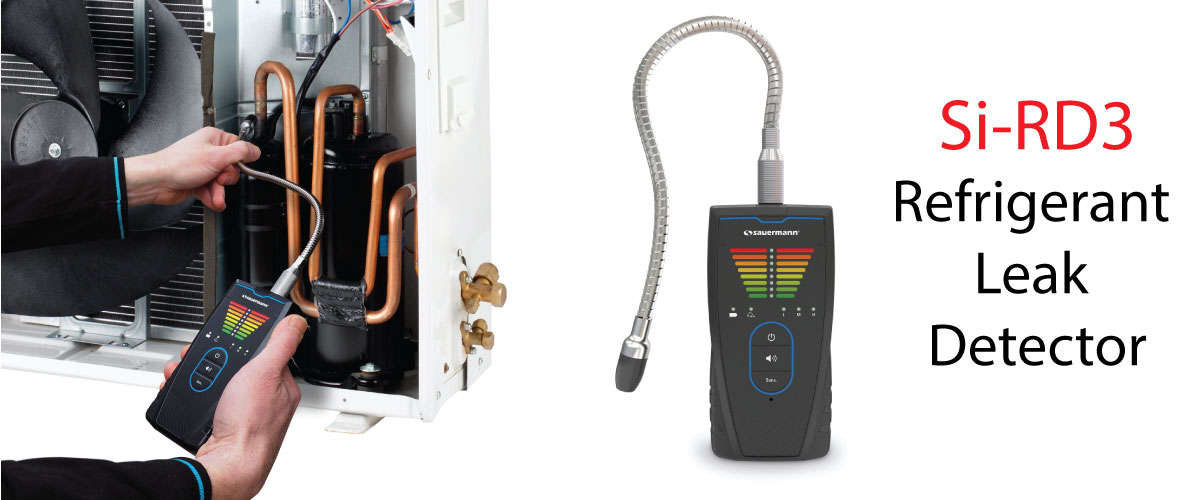The Sauermann Si-RD3 refrigerant leak detector uncovers leaks of most common refrigerant gases to a high degree of sensitivity, including all HCFC and HFC refrigerants, R1234yf, R1234ze, R290, R600a, and 5% hydrogen–95% nitrogen mixtures (Nidron 5 and Trace-A-Gas).
- Detects most common refrigerants and mixtures
- Visible and audible alarms
- Highly sensitive: 0 – 3 g/year
- 30 cm flexible probe
Features of the Sauermann Si-RD3 Refrigerant Leak Detector
- Detection includes: all HFCF and HFC refrigerants, R1234yf, R1234ze, R290, R600a, and 5%hydrogen - 95% nitrogen mixtures (Nidron 5, Trace-A-Gas)
- Manual and automatic autozero. Immediately ready to use with no presets.
- Heated diode sensor
- 3 modes: Low, Normal, and High sensitivity
Reglementations
The refrigerant gas detector complies with the EN 14624 standard that determines the following points:
- Minimum threshold of sensitivity: Fixed: < 1 g/year at 3 mm In moving air: 2 g/year, 2 cm/s at 3 mm
- Minimum time of detection (1 g/year): 1 second
- Autozero: 2 seconds
- Recuperation time after exposition: from 1 to 10 seconds (depending on detection level and threshold of sensitivity)
Download
Download the Technical Data Sheet for the Si-RD3 by Sauermann
What is a Refrigerant Leak Detector
A refrigerant leak detector is a device that is used to detect leaks of refrigerant gases from refrigeration and air conditioning systems. Refrigerant gases are used to transfer heat from one place to another. However, refrigerant gases can be harmful to human health and the environment if they leak into the atmosphere.
There are two main types of refrigerant leak detectors: electronic and manual.
Electronic refrigerant leak detectors use a variety of technologies to detect refrigerant leaks, including:
- Corona discharge: Corona discharge detectors work by detecting the electrical discharge that occurs when refrigerant gases leak into the air.
- Heated diode: Heated diode detectors work by detecting the change in the electrical conductivity of a heated diode when it is exposed to refrigerant gases.
- Infrared: Infrared detectors work by detecting the infrared radiation emitted by refrigerant gases.
- Ultrasonic: Ultrasonic detectors work by detecting the ultrasonic sound waves emitted by refrigerant leaks.
Manual refrigerant leak detectors use a variety of chemicals and dyes to detect refrigerant leaks. For example, soap bubble detectors use a soapy solution that will bubble when it comes into contact with refrigerant gases. UV dye detectors use a UV dye that will glow when it is exposed to ultraviolet light.
To use a refrigerant leak detector, simply follow the instructions that come with the device. Most electronic refrigerant leak detectors will have a visual and audible alarm that will go off if a leak is detected. Manual refrigerant leak detectors will typically require you to inspect the area for bubbles or dye.
When using a refrigerant leak detector:
- Make sure the area you are testing is well-ventilated.
- Start by testing the areas where refrigerant is most likely to leak, such as connections and fittings.
- Move the detector slowly and carefully over the area you are testing.
- If the detector alarms, inspect the area carefully for a leak.
- If you find a leak, repair it immediately.
It is important to note that refrigerant leak detectors can only detect refrigerant leaks that are large enough to be detected. If you suspect a refrigerant leak, it is always a good idea to have a qualified technician inspect your system.

